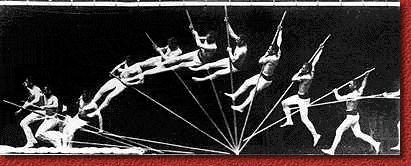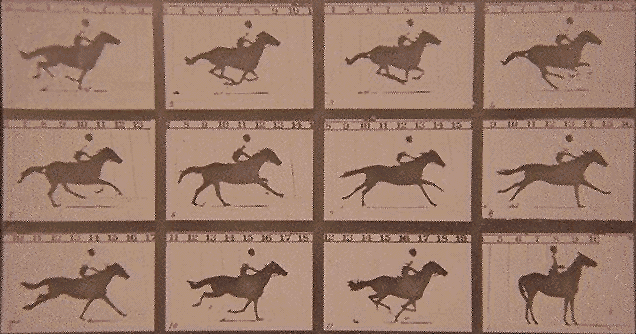Lecture topic:
Animation
Motion
is an
action which involves space and time and, strictly speaking, belongs to the
fourth dimension- something that does not at first sight seem an appropriate
category for the stationary world of two and three dimensional art. The ways
that artists "capture" the fourth dimension was, and still is, the
subject of much discussion.
Motion and emotion
both derive from the Italian
word moto. Physical motions
(walking people, galloping horses, postures, distortion, etc.) as well as
mental emotions such as sadness, joy, love and anger. If emotions were
depicted effectively through motion the viewer is "moved" by the
artwork.

Étienne-Jules Marey
Étienne-Jules Marey a French medical doctor, (1830-1904) wanted to make
the world visible, and measurable. He had several inventions with respect to
circulation, electrocardiography, respiration, and muscle function.
"In this method of
photographic analysis the two elements of movement, time and space, cannot both
be estimated in a perfect manner. Knowledge of positions the body occupies in
space presumes that complete and distinct images are possessed; yet to have
such images, a relatively long temporal interval must be had between two
successive photographs. But it is his notion of time one desires to bring to
perfection, the only way of doing so is to greatly augment the frequency of
images, and this forces each of them to be reduced to lines."
Étienne-Jules Marey, 1883
He was the inventor of
the "chronophotograph" (1887) from which
modern cinematography was developed. Some in fact see Marey,
rather than the Lumière brothers, as the true father
of cine photography.

Whereas Muybridge (with
whom Marey was frequently in contact) had used a
number of cameras to study movement, Marey used only
one, the movements being recorded on one photographic plate.
For those who think slow
motion photography is relatively new, Marey also
invented a slow motion camera in 1894, which took pictures at the rate of 700
per second!
Characteristic of his
pictures were his studies of the human in motion, where the subjects wore black
suits with metal strips or white lines, as they passed in front of the black
backdrops.

showing model as well
as motion suit markers

Correct
exposure showing only the motion suit 'markers
MUYBRIDGE, Eadweard
b. 9
April 1830; d. 8 May 1904

Edward James Muybridge was born in
During the late 18 sixties
and early 18 seventies he made some two thousand pictures, exposing negatives
size 20x24 inch. Though he is not given due acclaim, many his landscape studies
rank with the best.
However, Muybridge's main
claim to fame (apart from being tried and acquitted for the murder of his
wife's lover!) was his exhaustive study of movement. Just about this same time
the French physiologist Etienne Marey was studying
animal movement, and his studies began to suggest that a horse's movements were
very different from what one had imagined. One of the people who became aware
of this research was Leland Stanford, a former governor of
By the 1870s lengthy
exposures had been reduced to a minimum, and thus it became possible for
photography to begin to extend one's vision of reality. It took a little time,
however, for Muybridge to perfect a way of photographing which would supply the
answer, for the Collodion process was rather slow.
Returning to his movement
experiments, a few years later Muybridge was able to photograph a horse
galloping, using twenty four cameras, each triggered off by the breaking of a
trip-wire on the course. He not only proved Leland right, but also showed that,
contrary to what painters had depicted, a horse's feet are not, as hitherto
believed, outstretched, as if like a rocking- horse, but bunched together under
the belly. This discovery caused considerable controversy, but eventually
became more generally accepted.
Muybridge's studies are
very comprehensive, and include some detailed studies of men and women walking,
running, jumping, and many other activities.
Modern Motion Capture:
Time, change and sequence -
Egyptian art shows the passage of time by seria

In medieval art a well known device of placing pictures next
to one another - showing the before and after: Diptych (two panels) or
triptych (three panels) was used where the story could be read in
continuity: a sermon in pictures.


Garden of Earthly Delights
(opened and closed)
by Hieronymus Bosch c1510-15
More Triptychs
Seriality or
making a work in several sections is an effective way of moving a story along.
Roy Lichtenstein (b 1923) uses serials derived from comic books.

Continuous line is also a way to attract the
viewer's eye - curved lines suggesting movement. (motion
blur).

Still images or drawings can be made to animate using
registration of imagery and persistence of vision.
See the work of South African artist/animator William
Kentridge

http://www.awn.com/mag/issue3.7/3.7clips/9810kentridge.mov
http://www.awn.com/mag/issue3.7/3.7pages/3.7moinskentridge.html
The viewer can be stationary or moving physically amongst the
artwork. (Janet Cardiff, mazes, etc.)

Janet Cardiff
Art in Technological Times:
http://www.stretcher.org/archives/reviews/010101/010101.html
see: still motion site IDimaging\movement.html
Three D Modeling and
Animation
Spoof: how to make an animated movie:
http://video.google.com/videoplay?docid=-8683020727511417227
Some practical
suggestions for learning 3D graphics:
From Ian Stead (former
www.3dtotal.com
This site has a bunch of
free downloadable training videos for many different 3D and 2D computer
graphics software packages including Maya. They also have a forum. It's a great
place to start if you are starting to learn new 3D software.
A lot of this is just
common sense. Some of these things I've learned through experience, others are
good ideas I've read about or talked to other people about.
* Keep it simple (being
overly ambitious kills many projects).
* Plan ahead what you are
doing (draw! storyboard! collect reference!). Have fun. Don't try to learn everything
at once, there is so much to learn and it takes time to learn it, so I
recommend focusing on an area you wish to get better at instead of trying to
get better at everything at once (right now, I'm focusing on modeling/
texturing - I have very little experience in animation and I expect I won't be
very good at it for several more years).
* You don't have to be
good at all aspects of 3D, its okay to specia
* Understanding
composition is very helpful. Learning some architecture is useful for modeling
realistic spaces and buildings (I still need to do that).
* Understanding anatomy
and the human figure is essential if you are going to make characters (model
them and animate them). Taking a figuring drawing class is highly recommended.
It doesn't matter which software you use - it matters what you do with it.
* Also, everyone starts
out as a noob, so even the best artists one day
couldn't draw anything very realistically. Natural talent helps, but you don't
need it to be able to draw or do great 3D work, all you have to do is practice.
* Get a digital camera
and take pictures everywhere so you can build a texture and reference library -
you may not be working on what you are photographing today, but it will be
helpful later. Also, this way you will have more work on hand that you own the
copyright to.
* In the same vein,
collect reference material from magazines, the internet and everywhere. Collect
3D models and animations to look at for inspiration and to help you understand
how other people build/animate/render/draw things.
Here are some excellent
places to check out for learning 3D graphics and animation.
http://features.cgsociety.org/challenge
and www.cgtalk.com
These two sites are part
of CG Networks. They have several different CG challenges every two months
(animation, concept art, game art, architecture, visual fx and modeling) They have an excellent and large
forum on the cgtalk part of the site. There are a ton
of extremely talented artists who run and use these forums. It's a great place
to get inspired, and to learn. They have many useful forums for getting
critiques, for software specific advice and general discussion of computer
graphics and many other relevant topics.
Also, if you are strapped
for cash, and are looking for free solutions for animation and modeling, you
might check out these open-source 3D
programs:
Or, if you'd like to buy
some software at student prices, here's one place I know of (usually you can save
several hundred to several thousand dollars):
Additionally here is a link to get you going with the
jargon of 3D.
_________________________________________________________
Simple, but “moving”
animated gifs


_______________________________________
Stop Action Animation
Stop Action Animation is
an animation technique which makes static objects appear
to move. Stop motion is used to produce the animated movements of ANY objects,
such as toys, blocks, dolls, etc. If desired, we will permit the use of drawn
animation as well for this assignment.
All
animation, including all stop motion, requires a camera that can expose single
frames. It works by shooting a single frame of an object, then moving the
object slightly, then shooting another frame. When the
film runs continuously at 24 frames per second, the illusion of fluid motion is
created and the objects appear to move by themselves. This is similar to the
animation of cartoons, but using real objects instead of drawings.
Probably the most passive
form of stop motion is time lapse animation in which a stop motion camera is
simply clicked (manually or via an intermittent control device called an intervolometer) to take a frame of film as each
period of time lapses, as natural objects of nature and mankind move of their
own accord, non-interfered with by the animator. The most common uses for time
lapse stop-motion animation movie photography are moving clouds, seen daily
during weather forecasts in moving satellite imagery, the speeding up of the
growth of plants, and stars as they appear to "rotate" around the
Earth.
Cell Phone Claymation
From: DaggeH
15 year old from Sweden Claymation Video, Made with a W800i cell phone, took me bout
an hour and I used around 100 shots, clips clipped together in movie maker 2.0
(Windows
XP: Movie Maker 2.1 Download)
or for mac
users: imovie http://www.apple.com/ilife/tutorials/
Amazing Stop Motion
Animations: http://www.darkstrider.net/gallery2a.html
Claymation info: http://www.animateclay.com/
Spiderman stop action
movie: http://www.youtube.com/watch?v=6lTuSFILCp4&NR
Roger,
an example of stop motion
Stop Motion Pro http://www.stopmotionpro.com/whatis_1.htm
Tutorials: http://www.stopmotionpro.com/assets/resources/tutorials/SMP_canon_compact_start.html
http://www.stopmotionpro.com/tutorials.htm
Visiting artist: Shawn Lawson
Screenings: William Kentridge
______________________________________________________
Studio skills: Photographing motion,
animation, storytelling, drama, creativity, expression with moving objects
Project: Create a stop action animation
using any methodology. This could simply be a series of animated gifs, as we
did previously in Image Ready or a claymation project
or a series of interrelated drawings on paper or screen that are put into the
computer or… . The basic idea here is to create motion using still frames.
Some student examples:
http://www.arts.rpi.edu/public%5Fhtml/ruiz/public%5Fhtml/IDIspring04%2D01/ss5.html
Task: Considering the lectures
in plenary and in studio and your personal explorations of the animated image,
create a minimum 30 frame animation. Use the criteria above for guidance.
Deliverables: a minimum of 36 frames (3
seconds @ 12 fps) of your original animated sequence in a .gif or .swf flash player or quicktime
format
Grading
Criteria:
1.
Assignment completed on-time.
2.
Adherence to the size and file format specifications
3.
Appropriate use of animation
4.
Exploration and application of creative tools in creating animation
5.
Quality and clarity of class presentation
6. Quality of Inventiveness, expression, and imagination in your animated stop motion




